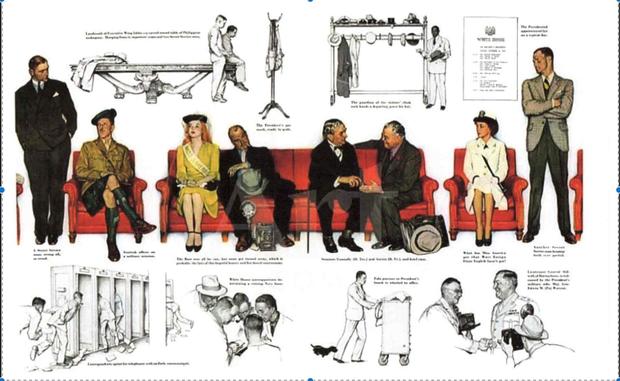One of Norman Rockwell’s most iconic paintings is of a happy family gathered for Thanksgiving dinner. Now, a family feud has spurred a legal brawl after one of its members spotted original drawings by the artist hanging in the White House on a 2017 television program — artwork that he believed he owned.
The saga of the disputed artwork begins in 1943, when Rockwell created a set of sketches called “So You Want to See the President” that was published in the Saturday Evening Post, where he worked as an illustrator for 47 years. That same year, Rockwell gifted the illustrations to Stephen T. Early Sr., who was President Franklin D. Roosevelt’s press secretary, according to legal documents.
But what happened next — and who owns the art — has become a matter of dispute, with Early’s descendants battling over the four art pieces, which depict a variety of people, from military officers to senators, waiting to see FDR.
Legal filings
While watching a 2017 television interview of former President Donald Trump, Thomas A. Early, one of Stephen Early’s three children, spotted the Rockwells hanging in a hall of the West Wing of the White House, according to a lawsuit filed Monday in U.S. District Court for the Eastern District of Virginia.
In watching the TV show, the lawsuit alleges, Thomas A. Early “learned for the first time that the Rockwells were at the White House.” Early died in 2020.
While it’s unclear how the family fight will settle, one thing is certain: The Rockwells are likely worth a tidy sum. One of Rockwell’s paintings sold a decade ago for $46 million — although it’s unlikely the disputed pieces would fetch anything close, given they are sketches and drawings.
Art laundering?
The artwork was supposed to be kept at the home of Thomas A. Early’s sister, Helen Early Elam, where the family had agreed it should be stored, the lawsuit alleges.
Instead, Helen Early Elam’s son, William Elam, allegedly “took the Rockwells to the White House to conceal his removal of the artwork … and to hide the Rockwells for a significant time period to ‘launder’ or ‘wash’ the ownership of artwork, in the effort to obtain sole ownership,” the lawsuit alleges.
The lawsuit claims Elam took the artwork to the White House in 1978 — during the Carter administration — “where they were placed on loan, with the lender listed as ‘Anonymous Lender.'”
After watching a 2017 TV program, Thomas A. Early had “promptly notified” the White House curator that he was a one-third owner of the Rockwells and that he intended his stake to be inherited by his children upon his death, the lawsuit states.
The lawsuit doesn’t accuse the White House or any officials of wrongdoing. The White House declined to comment on the “private dispute.” In 2022, the Rockwell artwork was taken down and replaced by a portrait of President Joe Biden, according to Politico.
“Sole owner”
In a separate lawsuit, William Elam alleges that he is in fact the sole owner of the artwork.
According to Elam’s suit, Stephen Early, FDR’s press secretary, allegedly gave the illustrations to his daughter, Helen, in 1949 when she graduated from the Pratt Institute in New York. She then gifted the artwork to her son William, the claim asserts.
Elam’s lawsuit also claims that the estate of his uncle Thomas A. Early, who spotted the artwork on TV in 2017, didn’t include the illustrations in his inventory of assets after his uncle’s death in 2020.
The lawsuit claiming that Elam hid the art in the White House is asking for damages of $350,000 as well as a judgment that the ownership is shared by the family’s descendants, while Elam’s lawsuit is asking that a court rule that the artwork belongs to him alone.
